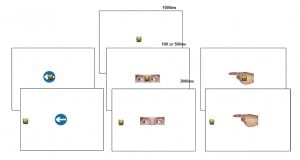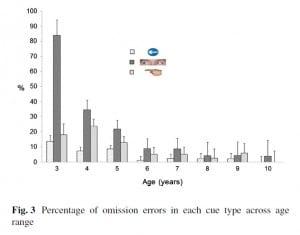We have a paper published this month in the journal Experimental Brain Research based upon 2 years of data collected at the Lincoln Summer Scientist event which looked at how children’s saccadic eye movements are affected by directional socio-biological cues (see previous posts here and here).
We report results from 137 children who performed a pro-saccade task presented as a computer game in which they had to keep their eyes on a cartoon bee that jumped unpredictably from the middle to the left or right of a computer screen. The Eyelink II system was used to examine how quickly and accurately the children followed the bee while pictures of arrows and photos of pointing hands and eyes appeared in middle the screen just before the “buzy bee” character moved (see Youtube video).
We found that children were distracted by the direction of the pointing pictures such that their eyes were quicker to move towards the cartoon bee when she jumped in the same (Congruent) as opposed to the opposite (Incongruent) direction to the pointing finger, eye or arrow. Interestingly for the youngest group of children (3-5 years) this effect was found most strongly for pointing fingers. Only older children showed the effect for eyes and arrows. The paper makes the case for the view that children have to learn to link what they see in the world around them with the direction of interesting information and events. One of the first “cues” to attention that young children learn may be the direction of an adult’s pointing index finger.
Another interesting finding of the work was that for the youngest group of children when eye gaze cues overlapped with the onset of the peripheral target bee a large proportion of “omission errors” were made such that they missed the target completely and didn’t make a saccade. I was involved in the testing myself at Summer Scientist and I found this feature of young children’s behaviour particularly fascinating. It seems strikingly similar to stimulus “extinction” and  neglect seen in adult stroke patients. Rather than just not moving their eyes I think 3-4 year olds didn’t “see” the Bee under these conditions and this is something I’d hope to follow up at future summer Scientist weeks.
neglect seen in adult stroke patients. Rather than just not moving their eyes I think 3-4 year olds didn’t “see” the Bee under these conditions and this is something I’d hope to follow up at future summer Scientist weeks.
The paper is full open access and available here . See here for another recent Experimental Brain Research study I’ve only recently seen by a group in Oslo showing ERP response to finger pointing cues in babies.